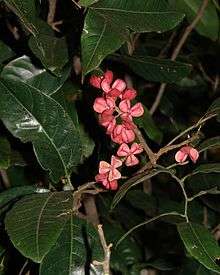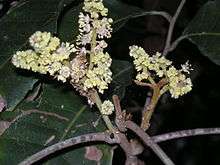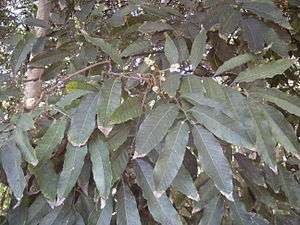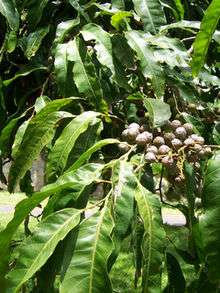Elattostachys
| Elattostachys | |
|---|---|
 | |
| Elattostachys microcarpa foliage and fruiting capsules, open, seeds gone | |
| Scientific classification | |
| Kingdom: | Plantae |
| (unranked): | Angiosperms |
| (unranked): | Eudicots |
| (unranked): | Rosids |
| Order: | Sapindales |
| Family: | Sapindaceae |
| Genus: | Elattostachys (Blume) Radlk.[1][2] |
| Species | |
|
See text | |
Elattostachys is a genus of about 21 species of trees known to science, constituting part of the plant family Sapindaceae.[2][3]
They grow naturally in the New Guinea, the Moluccas, Sulawesi, Indonesia, Timor, Australia, New Caledonia, Vanuatu, Fiji, Samoa, Niue, Tonga, Palau (Caroline Islands) and the Philippines.[2][3]
The known centre of diversity of New Guinea has nine known species recognised by science as of 2013.[4]
In Australia, they grow naturally through the northern half of the eastern coastal zone, northwards from the Newcastle region in New South Wales through eastern Queensland to the northernmost point of Australia Cape York Peninsula.[2][5][6][7][8] One of them E. xylocarpa has a common name of white tamarind, while another E. nervosa has a common name of beetroot tree. A few members of the Australian Sapindaceae are called tamarinds, although they have no close relation to the true tamarind, which is a member of the bean family.
Conservation
At the global scale, several Elattostachys species have been threatened with extinction, as officially recognised by the International Union for Conservation of Nature (IUCN).
Three New Guinea endemic species E. aiyurensis, E. goropuensis and E. rubrofructus, one Sulawesi endemic species E. erythrocarpum and one New Caledonia endemic species E. dzumacensis have been vulnerable to global extinction according to the IUCN's 1998 assessment.[9][10][11][12][13]
Naming and classification
European science formally named and described this genus in 1879, authored by Bavarian botanist Ludwig A. T. Radlkofer,[1][2][3] based on Carl Ludwig Blume's 1849 published Cupania sect. Elattostachys.
In 1992–3 Dutch botanist Frits Adema formally published new names and descriptions for numerous species and clarified species named previously, of the Pacific Islands and Malesia regions.[14][15][16]



Species
This listing was sourced from Flora Malesiana,[3] the Census of Vascular Plants of Papua New Guinea,[4] the Checklist of the vascular indigenous Flora of New Caledonia,[17] peer reviewed published scientific species descriptions journal articles,[14][15][16][18] the International Union for Conservation of Nature Redlist conservation status assessments,[9][10][11][12][13] the Flora of Micronesia checklist,[19] Flora Vitiensis (Fiji),[20] the Australian Plant Name Index and Australian Plant Census,[2] the Australian Tropical Rainforest Plants information system,[5] Fruits of the Australian Tropical Rainforest,[6] the Flora of New South Wales and the Flora of Australia.:[7][8]
- Elattostachys aiyurensis Adema[14] – New Guinea endemic[4][21] –
 Vulnerable[9]
Vulnerable[9] - Elattostachys angulosa Adema[14] – New Guinea endemic[4][22]
- Elattostachys apetala (Labill.) Radlk., syn.: E. falcata (A.Gray) Radlk.[1][20] – New Caledonia,[16] Vanuatu, Fiji,[15] Niue, Samoa, Tonga
- Elattostachys dzumacensis Adema[16] – New Caledonia endemic –
 Vulnerable[13]
Vulnerable[13] - Elattostachys erythrocarpum Adema[14] – Sulawesi endemic[23] –
 Vulnerable[12]
Vulnerable[12] - Elattostachys globosa Adema[14] – New Guinea endemic[4][24]
- Elattostachys goropuensis Adema[14] – New Guinea endemic[4][25] –
 Vulnerable[10]
Vulnerable[10] - Elattostachys incisa Radlk. – New Caledonia endemic[16]
- Elattostachys megalantha S.T.Reynolds[18][26] – endemic to NE. Qld, Australia[6][27]
- Elattostachys microcarpa S.T.Reynolds[18][28] – endemic to NE. and Cape York Peninsula, Qld, Australia[6][29]
- Elattostachys nervosa (F.Muell.) Radlk.[1] – NE. NSW[30] to SE. Qld, Australia, endemic[31]
- Elattostachys obliquinervis Radlk. – New Guinea endemic[32]
- Elattostachys palauensis Hosok. – Palau, Caroline Islands, endemic[19]
- Elattostachys rubrofructus Adema[14] – New Guinea endemic[4][33] –
 Vulnerable[11]
Vulnerable[11] - Elattostachys solomonensis Adema[14] – Solomon Is., New Guinea endemic[4]
- Elattostachys tetraporandra Radlk. – New Guinea endemic[4][34]
- Elattostachys venosa A.C.Sm. – Fiji endemic[15][20]
- Elattostachys verrucosa (Blume) Radlk. – Java, Philippines, Sulawesi, Bali, Lombok, Sumbawa, Sumba, Flores, Wetar, Timor, Moluccas[35]
- Elattostachys vitiensis Seemann ex Radlk. – Fiji endemic[15]
- Elattostachys xylocarpa (A.Cunn. ex F.Muell.) Radlk.[1] – NE. NSW[36] northwards though E. Qld to Bowen,[6] Australia, endemic[37]
- Elattostachys zippeliana (Blume) Radlk. – Borneo, Sulawesi, Moluccas, New Guinea[4][38]
References
- 1 2 3 4 5 Radlkofer, Ludwig A. T. (1879). "Ueber die Sapindaceen Holländisch-Indiens". Actes du congrès international de botanistes, d'horticulteurs, de négociants et de fabricants de produits du règne végétal tenu à Amsterdam, 1877 (in German). Leide: A. W. Sijthoff. pp. 82–.
- 1 2 3 4 5 6 "Elattostachys%". Australian Plant Name Index (APNI), Integrated Botanical Information System (IBIS) database (listing by % wildcard matching of all taxa relevant to Australia). Centre for Plant Biodiversity Research, Australian Government. Retrieved 19 Dec 2013.
- 1 2 3 4 Adema (1994) Flora Malesiana. Digitised, online "Elattostachys (Blume) Radlk.". Retrieved 19 Dec 2013.
- 1 2 3 4 5 6 7 8 9 10 Conn, Barry J. (2008+). "Elattostachys". Census of Vascular Plants of Papua New Guinea. (search result listing, matching all starting with "Elattostachys", via www.pngplants.org). Retrieved 19 Dec 2013. Check date values in:
|date=(help) - 1 2 Hyland et al. (2010) [RFK 6.1] "Factsheet – Sapindaceae". Retrieved 19 Dec 2013.
- 1 2 3 4 5 Cooper, Wendy; Cooper, William T. (June 2004). "Elattostachys (Blume) Radlk.". Fruits of the Australian Tropical Rainforest. Clifton Hill, Victoria, Australia: Nokomis Editions. pp. 489–490. ISBN 9780958174213. Retrieved 19 Dec 2013.
- 1 2 Harden (2001) New South Wales Flora Online. "Elattostachys". July 2001. Retrieved 19 Dec 2013.
- 1 2 Reynolds (1985) Flora of Australia. Online "Elattostachys (Blume) Radlk.". Retrieved 19 Dec 2013.
- 1 2 3 "Elattostachys aiyurensis Adema". IUCN Red List of Threatened Species. Version 2.3. International Union for Conservation of Nature. 1998. Retrieved 17 Dec 2013.
- 1 2 3 "Elattostachys goropuensis Adema". IUCN Red List of Threatened Species. Version 2.3. International Union for Conservation of Nature. 1998. Retrieved 17 Dec 2013.
- 1 2 3 "Elattostachys rubrofructus Adema". IUCN Red List of Threatened Species. Version 2.3. International Union for Conservation of Nature. 1998. Retrieved 17 Dec 2013.
- 1 2 3 "Elattostachys erythrocarpum Adema". IUCN Red List of Threatened Species. Version 2.3. International Union for Conservation of Nature. 1998. Retrieved 17 Dec 2013.
- 1 2 3 "Elattostachys dzumacensis Adema". IUCN Red List of Threatened Species. Version 2.3. International Union for Conservation of Nature. 1998. Retrieved 17 Dec 2013.
- 1 2 3 4 5 6 7 8 9 Adema, Frits (1992). "New species of Elattostachys (Blume) Radlk. (Sapindaceae)". Blumea. 36 (2): 541–550.
- 1 2 3 4 5 Adema, Frits (1993). "Elattostachys (Blume) Radlk. (Sapindaceae) in Fiji". Pacific Science. 47 (3): 295–297. Retrieved 19 Dec 2013.
- 1 2 3 4 5 Adema, Frits (1993). "Elattostachys (Blume) Radlk. (Sapindaceae) in New Caledonia". Bulletin du Muséum national d'histoire naturelle. Section B, Adansonia. 15 (1-4): 147–151. Retrieved 19 Dec 2013.
- ↑ Morat, P.; Jaffré, T.; Tronchet, F.; Munzinger, J.; Pillon, Y.; Veillon, J.-M.; Chalopin, M. (Dec 2012). "The taxonomic database "Florical" and characteristics of the indigenous Flora of New Caledonia" (PDF). Adansonia. sér. 3. 34 (2): 177–219. Retrieved 19 Dec 2013.
- 1 2 3 Reynolds, Sally T. (1985). "Notes on Sapindaceae in Australia, IV". Austrobaileya. 2 (2): 153–189. Retrieved 19 Dec 2013.
- 1 2 Wagner, W. L.; Herbst, D. R.; Tornabene, M. W.; Weitzman, A.; Lorence, D. H. (2012-). "Elattostachys palauensis Hosok.. Distribution: Caroline Islands - Belau (Ulebsechel)". Micronesia Checklist Query, Flora of Micronesia website. Smithsonian: National Museum of Natural History. Retrieved 19 Dec 2013. Check date values in:
|date=(help) - 1 2 3 Smith, Albert C. (1985). "Elattostachys (Blume) Radlk.". Flora Vitiensis nova: a new Flora of Fiji (Digitised, online, via biodiversitylibrary.org). 3. Lawai, Kauai, Hawaii: Pacific Tropical Botanical Garden. pp. 608–611. Retrieved 19 Dec 2013.
- ↑ Adema (1994) Flora Malesiana. Digitised, online "Elattostachys aiyurensis". Retrieved 19 Dec 2013.
- ↑ Adema (1994) Flora Malesiana. Digitised, online "Elattostachys angulosa". Retrieved 19 Dec 2013.
- ↑ Adema (1994) Flora Malesiana. Digitised, online "Elattostachys erythrocarpum". Retrieved 19 Dec 2013.
- ↑ Adema (1994) Flora Malesiana. Digitised, online "Elattostachys globosa". Retrieved 19 Dec 2013.
- ↑ Adema (1994) Flora Malesiana. Digitised, online "Elattostachys goropuensis". Retrieved 19 Dec 2013.
- ↑ Reynolds (1985) Flora of Australia. Online "Elattostachys megalantha S.T.Reynolds". Retrieved 19 Dec 2013.
- ↑ Hyland et al. (2010) [RFK 6.1] "Factsheet – Elattostachys megalantha". Retrieved 19 Dec 2013.
- ↑ Reynolds (1985) Flora of Australia. Online "Elattostachys microcarpa S.T.Reynolds". Retrieved 19 Dec 2013.
- ↑ Hyland et al. (2010) [RFK 6.1] "Factsheet – Elattostachys microcarpa". Retrieved 19 Dec 2013.
- ↑ Harden (2001) New South Wales Flora Online. "Elattostachys nervosa (F.Muell.) Radlk.". July 2001. Retrieved 19 Dec 2013.
- ↑ Reynolds (1985) Flora of Australia. Online "Elattostachys nervosa (F.Muell.) Radlk.". Retrieved 19 Dec 2013.
- ↑ Adema (1994) Flora Malesiana. Digitised, online "Elattostachys obliquinervia". Retrieved 19 Dec 2013.
- ↑ Adema (1994) Flora Malesiana. Digitised, online "Elattostachys rubrofructus". Retrieved 19 Dec 2013.
- ↑ Adema (1994) Flora Malesiana. Digitised, online "Elattostachys tetraporandra". Retrieved 19 Dec 2013.
- ↑ Adema (1994) Flora Malesiana. Digitised, online "Elattostachys verrucosa". Retrieved 19 Dec 2013.
- ↑ Harden (2001) New South Wales Flora Online. "Elattostachys xylocarpa (F.Muell.) Radlk.". July 2001. Retrieved 19 Dec 2013.
- ↑ Reynolds (1985) Flora of Australia. Online "Elattostachys xylocarpa (A.Cunn. ex F.Muell.) Radlk.". Retrieved 19 Dec 2013.
- ↑ Adema (1994) Flora Malesiana. Digitised, online "Elattostachys zippeliana". Retrieved 19 Dec 2013.
Cited works
- Adema, Frits (1994). "Elattostachys". In Adema, F.; Leenhouts, P. W.; van Welzen, P. C. Flora Malesiana. Series I, Spermatophyta : Flowering Plants. Vol. 11 pt. 3: Sapindaceae. Leiden, The Netherlands: Rijksherbarium / Hortus Botanicus, Leiden University. pp. 527–535. ISBN 90-71236-21-8.
- Harden, Gwen J. (Aug 2003). "Elattostachys – New South Wales Flora Online". PlantNET – The Plant Information Network System. 2.0. Sydney, Australia: The Royal Botanic Gardens and Domain Trust. Retrieved 19 Dec 2013.
- Hyland, B. P. M.; Whiffin, T.; Zich, F. A.; et al. (Dec 2010). "Home". Australian Tropical Rainforest Plants. Edition 6.1, online version [RFK 6.1]. Cairns, Australia: Commonwealth Scientific and Industrial Research Organisation (CSIRO), through its Division of Plant Industry; the Centre for Australian National Biodiversity Research; the Australian Tropical Herbarium, James Cook University. Retrieved 12 Dec 2013.
- Reynolds, Sally T. (1985). "Elattostachys". Flora of Australia: Volume 25—Melianthaceae to Simaroubaceae. Flora of Australia series. CSIRO Publishing / Australian Biological Resources Study. pp. 69–72. ISBN 978-0-644-03724-2.
| Wikimedia Commons has media related to Elattostachys. |